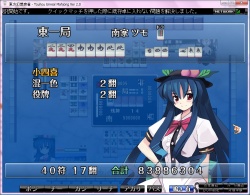Aotenjou: Difference between revisions
| Line 16: | Line 16: | ||
* [[Shousuushii]] + [[Tsuuiisou]] | * [[Shousuushii]] + [[Tsuuiisou]] | ||
: {{#mjt:1112233777z}} {{#mjt:4'44z}} Agari: {{#mjt:2z}} or {{#mjt:3z}} | : {{#mjt:1112233777z}} {{#mjt:4'44z}} Agari: {{#mjt:2z}} or {{#mjt:3z}} | ||
: | : With aotenjou, every aspect of this hand is considered, not just the yakuman patterns. This hand also includes the regular yaku of [[toitoi]] and [[sanankou]] as well as two or three [[yakuhai]] when applicable. This hand stands at 33 han and 50 fu via tsumo: | ||
:* 13 han from shousuushii | :* 13 han from shousuushii | ||
:* 13 han from tsuuiisou | :* 13 han from tsuuiisou | ||
:* 2 han from [[toitoi]] | :* 2 han from [[toitoi]] | ||
:* 2 han from [[sanankou]] | :* 2 han from [[sanankou]] | ||
:* 3 han from the maximum number of [[yakuhai]] | :* 3 han from the maximum number of [[yakuhai]] possible | ||
:* Basic points: {{sciencenotation|1.72|12}} | :* Basic points: {{sciencenotation|1.72|12}} | ||
Any [[dora]] to these examples definitely increases the hand even further. | |||
===Upper limit=== | |||
The exponential basic points equation does have an upper limit, imposed by the maximum possible han and fu combination. This cap only exists due to the maximum capacity with the finite tile count per hand. Per the [[rule variations]], the rules are applied to produce the maximum hand possible. | |||
== External links == | == External links == | ||
Revision as of 08:35, 13 December 2014

Aotenjou 「青天井」 is a non-standard scoring system, by which all caps and limits are removed. Per the scoring equation, han is factored exponentially in the equation:
- Basic points = fu × 2(2 + han)
Normally, the point equation has a cap applied at mangan, where the basic points is artificially maxed at 2000 points. Subsequent point values are then multiples of mangan for higher scoring hands.
With aotenjou, there is essentially no limit. The basic points have the freedom to be valued as high as possible, as the mangan limit is removed. Under aotenjou, scoring produces some ridiculously high numbers. Points are even much higher in conjunction with the multipliers applied for the dealer, non-dealer, and ron vs. tsumo wins. All yaku retain their original values. In additionally, yakuman patterns are defaulted at 13 han and are treated like normal yaku when determining the overall han and fu values. Furthermore, any han applied by dora counts as well to further increase the point values.
Hence, for this very reason, the scoring limits imposed by both mangan and yakuman are normally used.
Extreme scoring examples












 +
+
- This hand is then scored as 13 han 30 or 40 fu. By dealer, it is worth 7,864,400 (ron) or 1,966,080 all (tsumo).












 Agari:
Agari:  or
or 
- With aotenjou, every aspect of this hand is considered, not just the yakuman patterns. This hand also includes the regular yaku of toitoi and sanankou as well as two or three yakuhai when applicable. This hand stands at 33 han and 50 fu via tsumo:
Any dora to these examples definitely increases the hand even further.
Upper limit
The exponential basic points equation does have an upper limit, imposed by the maximum possible han and fu combination. This cap only exists due to the maximum capacity with the finite tile count per hand. Per the rule variations, the rules are applied to produce the maximum hand possible.